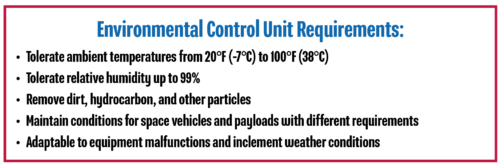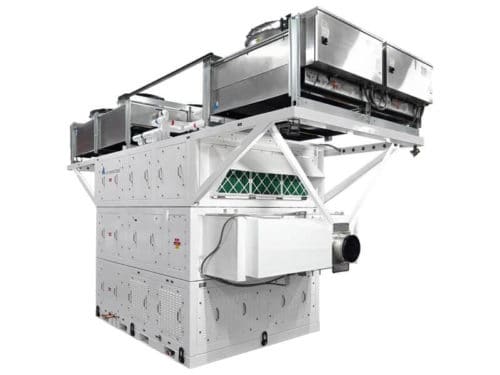Introduction
A private aerospace developer of reusable rocket engines for commercial, civil, national security, and human spaceflight, was referred to Air Innovations through connections in the aerospace industry. The company was commissioning an environmental control unit (ECU) to support its progressive mission to build safe, low-cost space rockets for civil, commercial, and defense customers. The system would need to keep critical and sensitive equipment safe during ground transportation from the rocket assembly facility to the launch pad.
The Challenge
The primary challenge was protecting payloads from the extreme weather conditions at the Cape Canaveral, Florida, launch site. The ECU would need to tolerate ambient temperatures ranging from 20°F (-7°C) in winter to 100°F (38°C) in summer and relative humidity up to 99%. Team members knew that space flight hardware would be vulnerable to damage during ground transport in these conditions. Similarly, an environment with too much humidity would create condensation on the equipment and threaten launch conditions.
Dirt, hydrocarbon contaminants, and other particles were also of significant concern as they could damage sensitive instruments in the payload. These pollutants, including dust, sand, and exhaust generated from trucks, would need to be removed by the ECU.
Additionally, the unit would need to maintain pristine conditions for space vehicles and payloads with different requirements. For example, the environmental control system would need to regulate conditions for both a rocket system for suborbital space tourism and a heavy-lift launch vehicle for carrying people and payloads to Earth’s orbit during ground transportation.
A unique challenge to the project was collaborating with the aerospace company during a global pandemic when in-person visits to the Kennedy Space Center in Florida were discouraged.
Finally, given the precious nature of the spacecraft equipment, the solution designed and built by Air Innovations would have to be adaptable to every possible scenario, including equipment malfunction, inclement weather conditions, and the occasional turtle crossing the road.
The Solution
As an environmental control specialist, Air Innovations had the depth of experience to design, test, and manufacture a highly specialized environmental control unit for the aerospace company configured to maintain a pristine environment within the Crew and Service Module (CSM) cover.
Air Innovations started by conducting extensive heat load calculations to tackle the significant fluctuations in temperature and humidity expected in Cape Canaveral. In anticipation of transporting valuable equipment in these extreme weather conditions, Air Innovations designed the system to function in ambient temperatures up to 120°F (49°C) and as low as 0°F (-18°C).
The refrigeration system within the unit was set to control the temperature between 50 – 100°F (10 – 38°C) with less than 60% relative humidity.
The system was configured to deliver between 1,000 to 3,500 CFM of air and up to two pounds of pressure per square inch (PSI). To prevent corrosion from salt air, the painted aluminum unit featured E-coated evaporator and condenser coils.
Highly sensitive filters, including carbon and HEPA filters, were designed to remove microscopic particles, hydrocarbons, and other gases that could corrupt delicate controls and sensors. 100% of the conditioned air was brought in from the outside, processed, and then delivered to the space flight equipment under the CSM cover. The pre-filtered air would pass over an electric heater for precise temperature control. Afterwards, the supply air would pass through the HEPA filter to remove any loose debris to reach 99.97% cleanliness, high enough to pass even rigorous cleanroom standards, before being delivered to the capsule.
The finished product included hot-gas bypass refrigeration control and a 12.5KW electric re-heater.
The ECU was designed entirely remotely and tested under those extreme conditions at the Air Innovations test facility in Syracuse, New York.
The Result:
In the end, Air Innovations designed an environmental control system that included the following:
- Cooling, heating, dehumidification, pre-filtration, and HEPA filtration
- Design output conditions of 45 – 81°F (7 – 27°C) ±2°F (±-17°C) with less than 60% relative humidity
- 3,500 CFM variable airflow capacity
- 40” external static pressure
- ISO class 8 filtration to 99.97% at 0.3µ HEPA
- E-coated evaporator and condenser coils
- Integral air-cooled condenser with nominal 15-ton scroll compressors
- Hot-gas bypass refrigeration control
- 5kW electric re-heater
- Compliance with all UL certification requirements
If you’re ready for a custom solution from Air Innovations, like this custom aerospace environmental control unit, contact us by submitting a project inquiry or calling 1-800-835-3268 today.
If you would like to see case studies for other industries, view our general case studies page. We also have whitepapers covering the semiconductor industry, pharmaceutical industry, and MyZone® systems product line. The whitepaper page can be found here.


